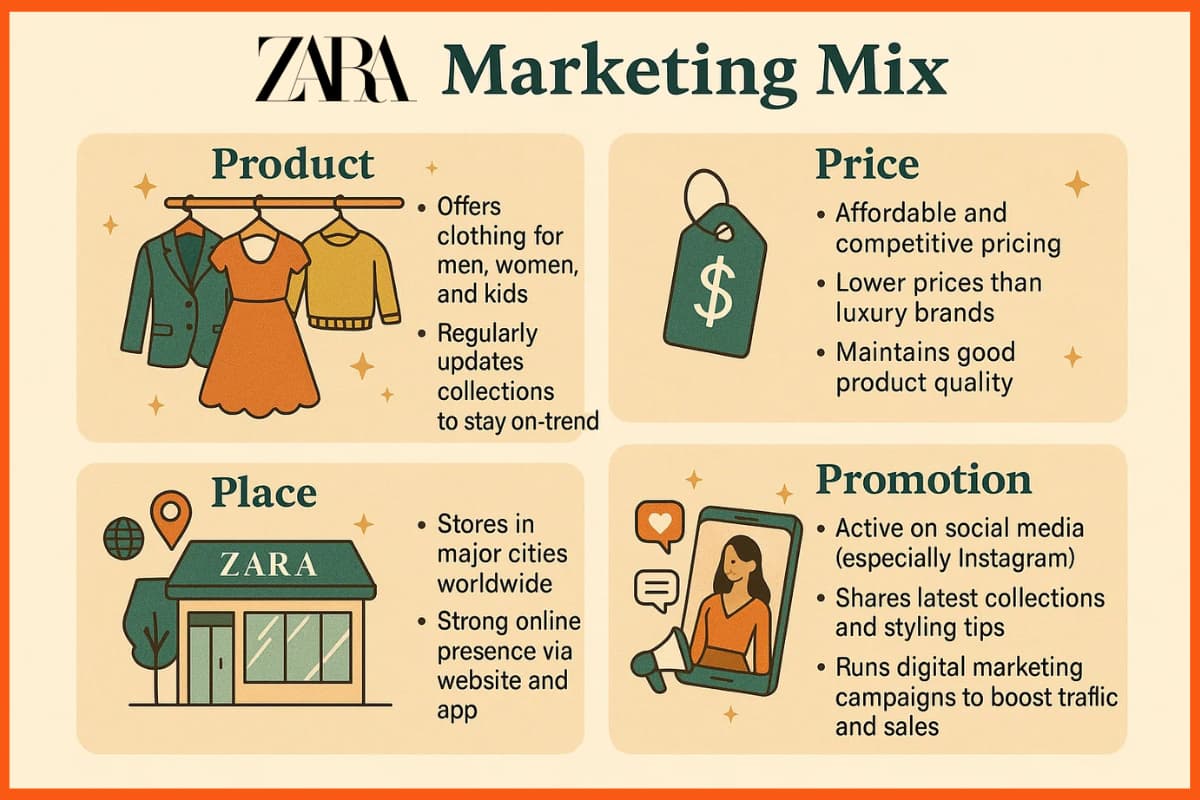Zara Marketing Strategy Explained: Promotion, Branding, and Digital Tactics Behind Its Global Success
🔍Insights
Zara - A name that resonates with fashion-forward individuals across the globe. With its unique blend of cutting-edge designs, affordability, and high quality, Zara has managed to create a loyal fan base that spans generations. The story of Zara is a remarkable one, with humble beginnings in the small town of Galicia, Spain.
Founded in 1975 by Amancio Ortega, Zara began as a small store selling affordable but stylish clothing to women. From those modest beginnings, Zara quickly rose to become a global fashion powerhouse with over 2,000 stores in 96 countries. Zara has the highest number of stores worldwide among all the apparel brands.
The secret to Zara’s success lies in its unique business model. Zara can bring a new design from concept to store shelves in just two weeks, while most other retailers take months. This means that Zara can quickly respond to changing fashion trends and offer new styles to its customers at a lightning-fast pace. In 2019, Zara’s sales exceeded $20 billion, making it the largest fashion retailer in the world.
Zara’s marketing strategies have played a crucial role in its success. The brand has always focused on creating a strong online presence and has invested heavily in digital marketing campaigns. Zara’s use of social media, particularly Instagram, has helped it reach a wider audience and engage with its customers in a more meaningful way.
Its commitment to sustainability is also worth noting. The brand has launched various initiatives to reduce its carbon footprint and minimize waste. Zara has pledged to use 100% sustainable fabrics in all of its collections by 2025, making it a trailblazer in the fashion industry.
Today, Zara continues to dominate the fashion market with its unique business model, strong online presence, and commitment to sustainability. With its finger firmly on the pulse of the latest fashion trends, Zara looks set to remain at the forefront of the fashion industry for many years to come.

Zara Target Audience
Zara Marketing Mix
Zara Marketing Campaigns
Zara Marketing Strategies
Zara Target Audience
Zara’s target audience is a diverse group of fashion-conscious individuals who appreciate high-quality clothing at an affordable price point. The brand’s demographic spans a broad age range, from teenagers to young adults and middle-aged individuals, with a strong focus on the 18-35 age group.
Geographically, Zara has a global presence, with stores in major cities around the world. However, the brand has a stronger presence in urban areas and is more popular among city dwellers than rural communities.
Zara’s target audience is characterized by their desire for fashion-forward clothing that is both trendy and timeless. They value quality over quantity and are willing to invest in pieces that they can wear for years to come. They are fashion-savvy and keep up with the latest trends, but they also have a unique sense of style that they like to express through their clothing choices.
Another key characteristic of Zara’s target audience is its appreciation for convenience. The brand’s fast fashion model means that new styles are constantly being introduced, and customers can always find something new and exciting to add to their wardrobe. Zara’s online shopping platform and mobile app also make it easy for customers to browse and purchase items from the comfort of their own homes.
The brand’s ability to cater to a wide range of tastes and styles has helped it establish a loyal fan base that spans the globe.
Zara Marketing Mix
Zara has become a household name in the fashion industry, known for its unique business model, innovative designs, and affordable pricing. The brand’s marketing mix plays a crucial role in its success, allowing it to reach a diverse range of customers and remain at the forefront of the fashion industry. Zara’s marketing mix consists of four key components: product, price, place, and promotion.

Product
Zara offers a wide range of clothing options for men. women, and kids. The brand’s design team is constantly updating and refreshing its collections to stay on-trend and offer customers the latest styles. Zara’s commitment to sustainability is also reflected in its product offerings, with the brand using more sustainable materials and production methods.

Price
Zara’s pricing strategy is affordable and competitive, making its clothing accessible to a wide range of customers. The brand offers clothing at a lower price point than some of its luxury competitors, but still maintains a high level of quality in its products.
Place
Zara has a strong retail presence, with stores located in major cities around the world. The brand’s website and mobile app also allow customers to shop online and have items delivered to their doorstep. Zara’s fast fashion model means that new products are constantly being introduced to stores and online, creating a sense of urgency for customers to make purchases.
Promotion
Zara’s promotion strategy is focused on creating a strong online presence and engaging with customers through social media. The brand uses platforms like Instagram to showcase its latest collections and offer styling inspiration to customers. Zara also invests in digital marketing campaigns to drive traffic to its website and promote its products.
Zara’s marketing mix is carefully crafted to appeal to a wide range of customers and stay ahead of the fashion industry. By continuously updating its product offerings, pricing strategy, retail presence, and promotion tactics, Zara remains a top player in the fashion industry.
Zara Marketing Campaigns
Zara is known for its innovative and engaging marketing campaigns, which have helped the brand maintain its position as a top player in the fashion industry. Some of the top marketing campaigns of Zara include:
- “The City” Campaign: In 2018, Zara launched a campaign featuring models walking through various cities around the world, showcasing the brand’s clothing in a visually stunning way. The campaign was successful in creating a strong emotional connection with customers and highlighting Zara’s global reach.
- “Forces of Nature” Campaign: This campaign, launched in 2019, focused on sustainability and featured clothing made from sustainable materials. The campaign was designed to raise awareness about the importance of sustainability in the fashion industry and highlight Zara’s commitment to sustainability.
- “Dear America” Campaign: In 2020, Zara launched a campaign in response to the Black Lives Matter movement, featuring a letter from the brand’s CEO expressing support for the movement and a commitment to diversity and inclusion. The campaign was successful in engaging with customers and promoting social responsibility.
Zara’s marketing campaigns have been successful in creating a strong emotional connection with customers, promoting inclusivity and sustainability, and highlighting the brand’s global reach and commitment to social responsibility.

Zara Marketing Strategies
Zara is a global fashion retailer known for its trendy and affordable clothing. The success can be attributed to its effective marketing strategies, which have helped it establish a loyal customer base and maintain its position as a top player in the fashion industry. Zara branding strategy emphasizes minimalism, fast fashion, and customer-centric design, creating a consistent and recognizable brand image across all markets. Here are the top marketing strategies of Zara:
Fast Fashion
Zara’s fast fashion strategy is one of the key reasons for its success. The brand releases new collections and products regularly, keeping up with the latest trends and styles. This creates a sense of urgency among customers to make purchases, which helps drive sales.
Limited Editions
Zara’s limited edition strategy involves creating limited quantities of certain products, which creates a sense of exclusivity and scarcity among customers. This strategy has been successful in creating buzz and generating demand for Zara’s products.

Social Media Marketing
Zara’s social media marketing strategy involves creating engaging content and interacting with customers on various social media platforms. The brand’s strong social media presence has helped it reach a wider audience and engage with customers on a personal level. Zara promotion strategy focuses on building a strong digital presence, leveraging social media platforms like Instagram, and running targeted digital campaigns to engage customers and drive online and in-store traffic.

In-store Experience
Zara’s in-store experience strategy involves creating a unique and memorable shopping experience for customers. The brand’s stores are designed to be visually appealing and easy to navigate, with new products and collections displayed prominently.

Influencer Collaborations
Zara digital marketing strategy focuses on leveraging social media, influencer collaborations, and targeted online advertising to enhance customer engagement and drive sales. Zara’s influencer collaboration strategy involves partnering with popular influencers and celebrities to promote its products on social media. This strategy has helped the brand reach a wider audience and tap into new markets.
Personalization
Zara’s personalization strategy involves using customer data to create personalized shopping experiences. The brand uses data such as customer preferences and purchase history to recommend products and create personalized marketing campaigns.
Sustainability
Zara’s sustainability strategy involves implementing various sustainability initiatives, such as using more sustainable materials and reducing waste in production. This strategy has helped the brand appeal to customers who value eco-friendly products and ethical production methods.
Community Engagement
Zara’s community engagement strategy involves partnering with local organizations and charities to give back to the community. This strategy has helped the brand build a positive reputation and create a strong emotional connection with customers.
Zara’s marketing strategies have been successful in creating a strong emotional connection with customers and establishing the brand as a top player in the fashion industry. Zara has been able to create a unique and memorable brand identity that resonates with customers on a personal level.
Global-Local Adaptation
Zara customizes its collections to align with cultural and regional preferences, adapting elements like sleeve lengths, fabric weights, and color palettes for different markets such as Japan, Brazil, and Europe. This thoughtful localization helps the brand stay relevant to local tastes while maintaining a consistent global identity. By closely monitoring customer feedback and market trends, Zara ensures its offerings resonate with each audience. This flexibility is key to Zara's success in diverse international markets.
Conclusion
For start-ups, there is much to be learned from Zara’s marketing strategies. By staying up-to-date with the latest trends and styles, creating a unique and memorable shopping experience, engaging with customers on social media, and implementing sustainability initiatives, businesses can create a strong emotional connection with customers and establish a loyal customer base. By following in the footsteps of Zara, businesses can create a brand identity that resonates with customers and drives sales.
Zara’s marketing strategies are a testament to the power of effective marketing in driving business success. By taking inspiration from these strategies, businesses can create a strong brand identity and establish a loyal customer base, paving the way for long-term success in the competitive world of retail.
FAQs
What is Zara target market?
Zara’s target audience is a diverse group of fashion-conscious individuals who appreciate high-quality clothing at an affordable price point. The brand’s demographic spans a broad age range, from teenagers to young adults and middle-aged individuals, with a strong focus on the 18-35 age group.
What is Zara digital marketing strategy?
Zara’s digital marketing strategy centers on social media, showcasing new collections and trends through visually appealing content. It uses targeted ads and emails to reach customers, focusing on organic engagement rather than heavy discounts or influencer promotions.
What is Zara marketing strategy?
Here are the main marketing strategies of Zara -
- Fast Fashion
- Limited Edition
- Social Media Marketing
- In-store Experience
- Influencer Collaborations
- Personalization
- Sustainability
- Community Engagement
Must have tools for startups - Recommended by StartupTalky
- Convert Visitors into Leads- SeizeLead
- Website Builder SquareSpace
- Manage your business Smoothly Google Business Suite







